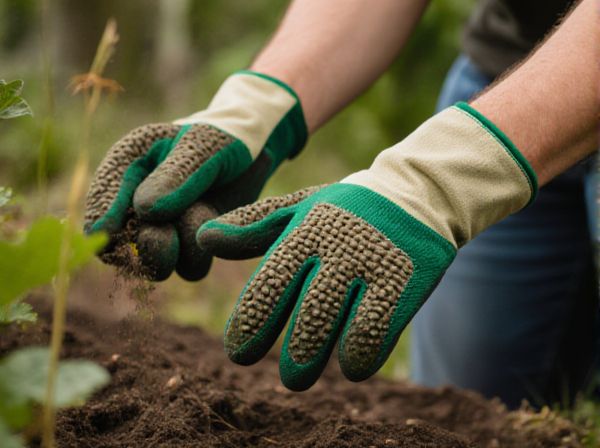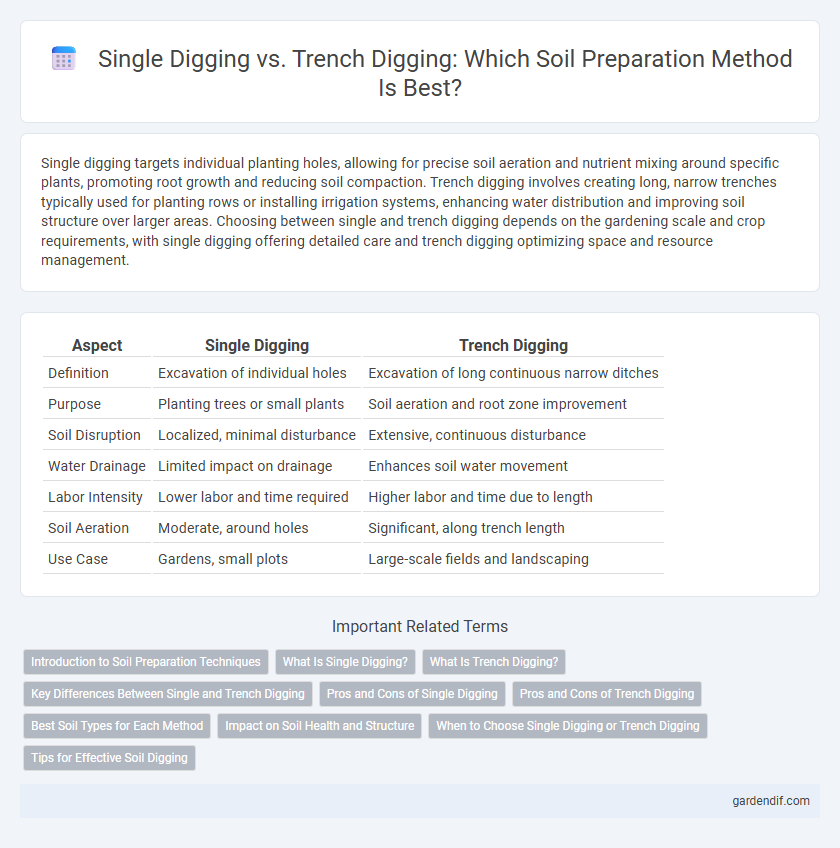
Single Digging vs Trench Digging Illustration
Single digging targets individual planting holes, allowing for precise soil aeration and nutrient mixing around specific plants, promoting root growth and reducing soil compaction. Trench digging involves creating long, narrow trenches typically used for planting rows or installing irrigation systems, enhancing water distribution and improving soil structure over larger areas. Choosing between single and trench digging depends on the gardening scale and crop requirements, with single digging offering detailed care and trench digging optimizing space and resource management.
Table of Comparison
| Aspect | Single Digging | Trench Digging |
|---|---|---|
| Definition | Excavation of individual holes | Excavation of long continuous narrow ditches |
| Purpose | Planting trees or small plants | Soil aeration and root zone improvement |
| Soil Disruption | Localized, minimal disturbance | Extensive, continuous disturbance |
| Water Drainage | Limited impact on drainage | Enhances soil water movement |
| Labor Intensity | Lower labor and time required | Higher labor and time due to length |
| Soil Aeration | Moderate, around holes | Significant, along trench length |
| Use Case | Gardens, small plots | Large-scale fields and landscaping |
Introduction to Soil Preparation Techniques
Single digging involves manually turning over soil to a depth of 20-30 cm, promoting aeration and root penetration, ideal for small garden plots. Trench digging creates deeper, narrow trenches up to 50 cm or more, improving drainage and soil structure for crop roots in larger agricultural areas. Both techniques enhance soil fertility but differ in depth, labor intensity, and suitability for specific soil types and plant requirements.
What Is Single Digging?
Single digging refers to the process of turning over the soil to a depth of about 20-25 cm, typically using a spade or shovel, to aerate the soil and prepare it for planting. This method improves soil structure, enhances water infiltration, and promotes root growth by loosening compacted layers without extensive disruption. Compared to trench digging, single digging is less labor-intensive and is ideal for routine garden bed preparation and soil maintenance.
What Is Trench Digging?
Trench digging involves creating long, narrow excavations typically used for utilities installation, drainage systems, or foundation footings. This method allows precise, linear openings with consistent depth and width, ideal for laying pipes or cables. Unlike single digging, trench digging minimizes soil disturbance while providing clear access for infrastructure placement.
Key Differences Between Single and Trench Digging
Single digging involves loosening soil to a depth of about 20-25 cm, primarily aimed at aeration and root penetration, making it suitable for routine garden maintenance. Trench digging, on the other hand, digs deeper trenches around 40-60 cm, often used for planting trees or installing pipes, providing enhanced soil structure improvement and nutrient mixing. The key difference lies in the depth and purpose, with single digging focusing on surface soil health and trench digging targeting deeper soil layers for extensive cultivation or construction needs.
Pros and Cons of Single Digging
Single digging improves soil aeration and root penetration by loosening compacted layers, enhancing water infiltration and nutrient absorption, which boosts plant growth. However, it can be labor-intensive and less efficient for large-scale projects compared to trench digging, as it only disturbs a limited soil volume. Single digging also risks surface soil erosion if not managed properly, reducing long-term soil fertility.
Pros and Cons of Trench Digging
Trench digging allows for precise placement of utilities and drainage systems with minimal surface disruption, improving project efficiency in confined urban areas. However, it poses risks such as soil instability and increased safety hazards for workers due to deeper, narrow excavations. Maintenance and repair tasks benefit from easier access within trenches compared to single digging, though costs may rise due to specialized support and shoring requirements.
Best Soil Types for Each Method
Single digging is most effective in heavy clay soils and compacted subsoils where deep loosening is required to improve aeration and root penetration. Trench digging excels in sandy and loamy soils that benefit from extensive soil turnover and mixing of organic matter to enhance fertility and drainage. Choosing the appropriate method based on soil texture optimizes soil structure and supports healthier plant growth.
Impact on Soil Health and Structure
Single digging disturbs the soil minimally, preserving natural soil horizons and maintaining microbial communities essential for nutrient cycling and soil fertility. Trench digging, by contrast, disrupts a larger volume of soil, leading to increased soil compaction and erosion risks, which can degrade soil structure and reduce aeration. Maintaining optimal soil health requires balancing excavation depth with minimal disturbance to protect soil aggregation and organic matter content.
When to Choose Single Digging or Trench Digging
Single digging is ideal for small garden beds or flower patches where minimal soil disturbance and aeration are needed, promoting healthy root growth with less labor. Trench digging suits larger areas requiring deep soil loosening and improved drainage, such as vegetable gardens or landscaping projects, enabling better water penetration and nutrient absorption. Choose single digging for shallow cultivation tasks, while trench digging is preferred for intensive soil preparation in extensive planting sites.
Tips for Effective Soil Digging
Effective soil digging requires understanding the benefits of single digging and trench digging techniques to optimize soil aeration and root penetration. Single digging involves loosening the soil to a depth of 20-30 cm, ideal for small garden plots, while trench digging allows deeper cultivation, reaching 45-60 cm, suitable for heavy or compacted soils. Using sharp, sturdy tools, maintaining consistent depth, and avoiding excessive soil disturbance preserve soil structure and promote healthy plant growth.
Single Digging vs Trench Digging Infographic

 gardendif.com
gardendif.com